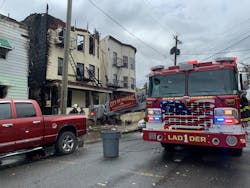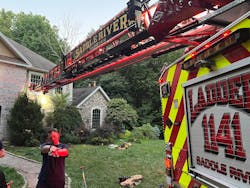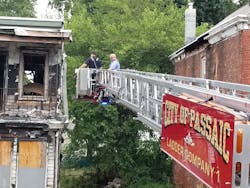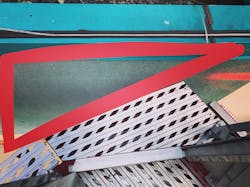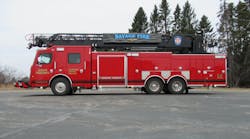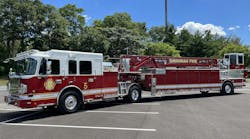If your department has any type of ladder truck, you must know how to use it to the full extent of its capabilities. In other words, there’s no excuse for not understanding how to maximize the operational potential of the aerial.
Contrary to popular belief, there’s a difference between a driver and an operator. Anyone can drive an apparatus: go forward in a straight line, reverse and make some turns. An operator understands the vehicle and is able to operate it to its fullest capacity. Some people are able to pump and get water in the line, while true operators are able to get you a draft from moving water and flow multiple lines.
The competent truck chauffeur is able to get the apparatus into unique situations to get the bucket/platform or the ladder to the window where a victim is calling for help or to get that master stream into position to knock down the bulk of the fire.
No matter what kind of aerial apparatus that you have, positioning concepts must be understood: for rescue, for ventilation, for master streams, for ingress/egress and for special situations.
Rescue
When you set up for a rescue, you have one shot to make it count. How you approach that victim will affect a split-second decision that might be required. If you approach from below, the person might jump onto/into your aerial. Approaching from above might hold the person a second until the rungs/bucket come into the individual’s zone.Ventilation
Setup for ventilation depends on whether members intend to vent from the aerial or to get off of the aerial to make a vent point somewhere else on the roof.
When you set up with the wind at the backs of the venting crew, there’s potential for fire to come out toward the members as they vent. That’s why you attempt to manipulate where the fire will vent out of the building, to give your brothers and sisters an opportunity to clear out what they’re pushing in.
Master stream
Setting up the aerial master stream depends on your training and your department’s standard operating procedures (SOPs)/standard operating guidelines (SOGs).
Setting up to flow from below gives you the best opportunity to knock down fire through windows and/or storefronts. Setting up aerials high in the sky and flowing down on top of roofing materials that collapsed doesn’t do much. There still are pockets of fire and more work to be done.
Ingress and egress
Setting up for an ingress and egress is for all of us. The aerial is capable of reaching spots that ground ladders can’t reach and/or might be quicker and safer to set up.
Special situations
How one sets up for special situations depends on the specific situation.
You might need to set up for a high point to conduct a rope rescue operation. You might need to set up at a parapet to transfer a patient from the roof of the structure to the ground. You might need to utilize the aerial for a water rescue.
Think outside of the box, because one day over the course of a 30-year career, there’s a good chance that you might experience that particular circumstance.Able to adapt
Ladders/sticks and buckets/platforms have different capabilities and limitations.
A stick essentially can be considered a large industrial- strength ladder. A bucket is a platform or basket area at the end of a similar ladder. The primary purpose of both of these is to get the members of your crew from point A to point B. Given this fact, no matter which type of aerial that you operate, you must be able to adapt and overcome potential concerns, such as overhead obstructions, tight buildings and setbacks. Overhead obstructions can come in the form of power and communication wires or trees and vegetation, to name a few.
One way to overcome operating with overhead obstacles is to get the turntable under them. For example, in the circumstance of wires, if you’re able to get the turntable under the wires, there’s a good chance that you will be able to get your aerial to your target. However, this opens up additional concerns, such as your distance to other telephone poles/trees and the ability to raise out of the cradle.
Furthermore, if your aerial is positioned under wires, you also must consider your terrain. Are you setting up on a sidewalk, in a driveway or on a grassy area?
All of this might seem basic, but it all comes together in a split second when you have that one shot to get the position. Always follow your SOPs/SOGs and manufacturers’ recommendations but also be aware of what the apparatus can do.
Three ladder positions
The straight stick ladder can be used in many ways. Depending on your department, it can be more than just a tool for accessibility. Sometimes, it can be used to mechanically ventilate small gables and residential windows.
When the discussion arises about the positioning of the ladder, you can go down a rabbit hole of approaches. For example, when operating at a window, one school of thought teaches to get the ladder into the opening of the window to minimize gaps between the building and the equipment. Others preach to get the tip of the ladder as close as possible to the building without making contact. Still others say align the rungs of the ladder to the sill of the window to make transitioning in and out of the window easier.
Lining up the top of the rails/beams to the window places the rungs below the sill. That allows for a slight area of refuge for a firefighter to get low to be better protected in the event that the conditions rapidly change in that respective room. In other words, a firefighter has the potential layout on the rugs of the ladder to take cover.
This positioning also allows for firefighters to straddle or slide into the room.
To each his or her own, but knowing the differences between the three positions at a window might help someone someday.Bucket positioning
The tower/bucket/elevated platform is one of the most versatile pieces of equipment in the fire service. Depending on the manufacturer, there are different variations to the bucket, but the operational considerations are very similar. When operating at a window with a bucket, you must be mindful of the gap that’s created between the bucket and the building. Often, this gap creates a triangle trap through which a firefighter or victim has the potential of falling while going in or out of the bucket.
Positioning the bucket to the window with the flooring of the bucket in line with the sill of the window might make entry into that space easier—just as in the case of the ladder. A member steps down into the room. However, once again, should something happen and the member requires quick egress, that individual would be going up and into the bucket.
Positioning the bucket below the windowsill about halfway on the bucket can mimic a similar approach to the ladder being below the windowsill. Be mindful of your respective bucket, because the configurations of how the bucket is connected to the ladder or boom and the height of the basket alter your approaches.
When the master stream gets put into service in a bucket, you want to be below or at the sill, to get water underneath the fire of a roof system or the flooring above.
Know now, not later
Don’t wait until that job comes in to figure out whether something will work. Know whether it will work. Many components contribute to maximization of the operational potential of an aerial. Have the conversation and think about it.
